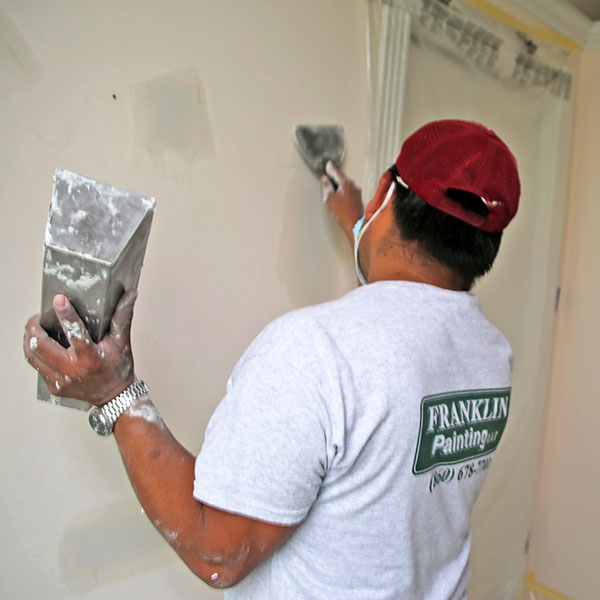
Are you planning to paint a bathroom, kitchen, or another high-moisture area? Tackling an interior paint project in a room with high humidity requires extra preparation prior to painting. If you don’t choose the right type of interior paint for your Connecticut home, it may end up peeling, cracking, or becoming a breeding ground for mold or mildew. However, you can prevent these problems by following these top three tips for painting in your home’s high moisture areas.
Tips for Painting Humid Rooms
Choose a Satin or Semi-Gloss Paint
What sheen of paint you use in a bathroom or kitchen significantly impacts its longevity. Paints with a glossy sheen—like satin or semi-gloss—are best for humid rooms. Instead of absorbing moisture like matte or eggshell paint, they deflect it. Glossy paints can resist moisture because they have a more complex finish. Another benefit of using glossy paint is that it is easy to clean. You will be able to wipe away food splatters or soap splashes without washing away the color on your walls.
For the bathroom ceiling and walls, choosing a paint specifically designed for high moisture areas is crucial. The best paint for bathroom ceilings and walls is often a high-quality semi-gloss or satin finish that provides durability against humidity and frequent cleaning. Waterproof paint for bathroom walls and specific bathroom paint finishes are formulated to resist mold and mildew growth, making them ideal choices. When selecting bathroom paint, consider products available at home improvement stores. They offer a range of options suitable for kitchen and bathroom environments. Remember, the type of paint for bathroom ceilings should also have anti-microbial properties to prevent mold build-up. For optimal protection and aesthetics, select the best paint finish for a bathroom, prioritizing moisture resistance and ease of cleaning.
 Prep the Surface
Prep the Surface
Before you start painting, clean the walls and smooth out imperfections. This step is vital because cleaning the surface will help the paint adhere. In addition, you won’t have to worry about unattractive spots detracting from your new wall color. (One con of glossy paint is that it makes imperfections stand out more than other types.)
If the old paint on the walls is cracked, peeling, or moldy, use a stiff-bristled brush to scrape it away. (Be sure to wear a protective face mask if removing mold so that you don’t breathe in the spores.) Next, smooth out any rough edges with fine-grade sandpaper.
Once the surface is prepped and smooth, it’s time to select the ideal paint for your bathroom. Choosing a paint specifically formulated to withstand moisture is critical for humid bathrooms. Products like waterproof paint for bathroom walls or mold-resistant bathroom ceiling paint are designed to handle the steamy conditions typical in these spaces. Retail brands offer options tailored for bathroom environments, ensuring durability and resistance against peeling or mildew growth.
Opt for a semi-gloss or satin finish—these are the best paint finishes for a bathroom as they repel moisture effectively and simplify cleaning. When deciding what paint is best for a bathroom, prioritize those with built-in protective features to maintain a fresh look and hygiene over time. Remember, the effort you put into selecting the correct type of paint and preparing the surface will result in a beautiful, long-lasting finish that enhances your bathroom’s functionality and aesthetics.
Follow the manufacturer’s instructions on the package to use a suitable filler. Once the filler has dried, smooth out the surface with fine-grained sandpaper.
Prime the Walls
Homeowners often skip this step when painting an room, but we don’t recommend skipping primer. Applying primer paint conceals wall imperfections like nicks and patches, helps new paint adhere to the wall, covers stains, and blocks odors. These benefits of primer paint are worth the extra cost and effort.
Now you know the secrets to painting high humid rooms without the risk of your new paint peeling or cracking in the future:
- Choose glossy paint.
- Prep the walls.
- Apply a primer.
The only detail you have to think about now is what color to choose. If you are looking for inspiration for your bathroom, check out HGTV’s Top 20 Bathroom Paint Color Ideas. Southern Living has put together a beautiful slideshow of Bold Kitchen Paint Ideas. For more inspiration for your interior paint project, check out our list of Paint Colors that are Reigning Supreme in 2021.
If you are looking for neighborhood painters to tackle your next painting project, give Franklin Painting a call! Our professional painting crews provide interior paint services for residents throughout central Connecticut.

Frank Campanelli, the esteemed founder of Franklin Painting LLC, has been leading the company since 1986. He takes immense pride in the stellar reputation his dedicated team has built by consistently delivering top-notch service to each customer.

